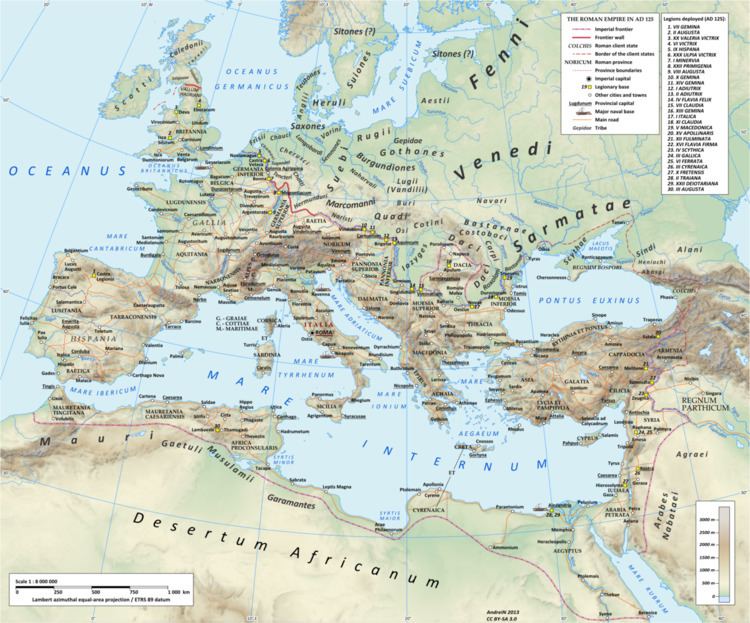 | ||
This article lists auxilia, non-legionary auxiliary regiments of the imperial Roman army, attested in the epigraphic record, by Roman province of deployment during the reign of emperor Hadrian (r. 117–138 CE).
Contents
- Types of regiment
- Contents of tables
- Ethnic composition of regiments
- Glossary
- Imperial dedications
- Raised during the Illyrian revolt
- Other non ethnic regimental names
- Unit Epithets
- References
The index of regimental names explains the origin of the names, most of which are based on the names of the subject tribes or cities of the empire where they were originally recruited. (As time went by, they became staffed by recruits from anywhere, especially from the province where they were deployed.)
Types of regiment
During most of the Principate era, until 212 CE, auxiliary regiments, called auxilia by the Romans, were formations kept separate from the legions, who were recruited from Roman citizens only. Auxilia were mostly recruited from the peregrini, the vast majority of subjects in the Roman empire who did not hold Roman citizenship. (in 212 CE, all the inhabitants of the empire were granted Roman citizenship).
There were three basic types of auxiliary regiment:
A number of regiments, of all three types, were designated sagittariorum (sagitt), indicating that their members were equipped as archers. After about 80 CE, about 12 percent of regiments were enlarged from the quingenarie size and designated milliarie, which nominally consisted of 1000 soldiers, but in reality consisted of 720 soldiers, 800 soldiers, and 1040 soldiers respectively.
Contents of tables
Table I below lists auxiliary regiments during Hadrian's rule, for which there is the most comprehensive evidence. The table does not show regiments that were attested to in the 1st century but that, according to Holder, were dissolved by 117 CE, nor those that were probably founded after 138 CE. The precise number of regiments that existed during Hadrian's rule is disputed. The regiments are listed by the Roman province where they were deployed c. 130 CE.
Ethnic composition of regiments
The rule of the first emperor, Augustus, (30 BCE–14 CE) saw the foundation of the majority of the regiments attested in Hadrian's time. In the earlier part of this period, regiments were raised from and named after individual tribes, for example Campagonum, Trevirorum and Bessorum. Later, units were raised from and named after broad national groups, for example Hispanorum, Gallorum, and Thracum.
There is very little evidence concerning the organisation and policies of auxiliary recruitment. The ethnic origins of auxiliary recruits are attested in only a tiny fraction of cases. For example, the cohors II Gallorum veterana equitata must have recruited a calculated 8,000 soldiers over its probable lifespan of about 250 years but the origins of only two rankers are known. Conclusions about auxiliary recruitment drawn by scholars from the available evidence is regarded as tentative.
According to Holder, during the Julio-Claudian dynasty (14–68 CE), regimental ethnic identity was preserved to some extent, with evidence of continued recruitment from the original people. By the time of Hadrian, however, a regiment's name, in most cases, probably represented the ethnic origin of few, if any, of its members. This is because during the Flavian dynasty (69–96 CE), as a matter of deliberate policy, most regiments were deployed in provinces far from their original home and drew the majority of their recruits from local natives and the rest from all parts of the empire. In most cases, therefore, a regiment's name had become an identification tag devoid of ethnic significance. A regiment deployed long-term in the same province would thus, over time, acquire the ethnic character of its host population.
There are exceptions to this rule:
Glossary
Some regiments were named after other people, for example ala Sulpicia after its first, or early, praefectus. In the Augustan era, commanders of auxiliary units were often Roman legionary centurions, or native chieftains. For example, ala Gallorum Atectorigiana was probably once commanded by a Gallic chieftain named Atectorix. Later, emperor Claudius restricted auxiliary commands to the lower aristocratic class of equites only.
Imperial dedications
In the 4th century, Valeria referred to emperor Diocletian (r. 284–305 CE) and Flavia to Constantine I (r. 312–337 CE) or some of his successors.
Raised during the Illyrian revolt
Names of regiments originally raised by emperor Augustus during the Illyrian revolt (6–9 CE) from Roman citizens unsuitable for service in legions, such as vagrants, convicted criminals, debtors, and emancipated slaves:
After their initial recruitment of Roman citizens, these regiments recruited non-citizens (peregrini) like all other regiments.
Other non-ethnic regimental names
Unit Epithets
Some regiment names included additional descriptors:
